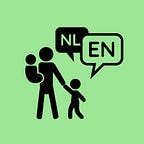Language development: stage of linguistic completion (5+ years)
In this blogseries I will talk about the language development or acquisition of a child, both monolingual and bilingual (or multilingual). Be sure to read the previous blogposts about preverbal development, the one-word stage, the two-word stage, the stage of linguistic differentiation and the introductory blogpost about the different stages I will mention and the most used defining terms. If at any moment you don’t understand the abbreviations used, go check them out here!
This post is divided into three sections, one for monolingual development (MFLA), one for simultaneous bilingual development (BFLA) and one for sequential bilingual development (SLA).
In this post I will talk about the last stage of language development and acquisition. Logically it is called the stage of linguistic completion, in which the language development is completed. Technically, everybody always continues to develop and there is never a moment in time that language is absolutely completed. In the practical sense though, it means that components like grammar and articulation are without any developmental faults around the age of 10 years. After that people don’t really learn more by adding new structures or rules (growing upwards), but increase in amount of words and language style and use (growing in width).
During the stage of linguistic completion, most aspects will further develop until they are without fault or as good as will ever be. This includes the phonological development (articulation), syntaxis (creating sentences) and morphology (changing words according to gender/grammar/plural/etc). Some mistakes will still be made until the age of 10, depending on how consistent a language is. The more exceptions to the rules, the longer it will take a child to correctly learn and use them all. For example in pronunciation: Spanish and Polish are quite clear, while English has lots of different options for different combinations.
In this stage, there are also some new aspects within the language development. A main one is literacy. While not officially part of learning a language, being able to read (and write) does open up a whole new world which affects the speed of learning vocabulary and new ways of saying things (proverbs, passive sentences, quoting someone).
Language also becomes more than just a way to communicate. Children become interested in poetry as they understand things like rhyming and alliteration, they also start to explore proverbs and start appreciating and making jokes. Children might start to insult others or purposely use their words to invoke emotions (good or bad). Another favourite for this stage is riddles, and actively questioning the meaning of certain words (e.g. why is a circus called a circus, and not a house of wonders?)
As there is almost no distinction between the language acquisition of monolinguals or bilinguals, especially at this late stage, all information stated above also applies to the BFLAs. Just as in previous stages, cross-linguistic influence exists with bilingual people.
As children in this stage are quite developed in their meta linguistic skills, they tend to be more accepting and conscious of other people’s languages and dialects. As already written in one of the first pieces in the series, children are roughly capable of using the correct language in the correct environment and situation. At this stage however, this is pretty much perfect and consistent. This doesn’t however mean that code-mixing and switching is gone entirely, especially when the environment understands both languages or mixes themselves.
As children learn to read and write, it might be good to let one of the languages be learned first. Especially when dealing with languages using the same script, it can be confusing to learn that a sound is attached to a letter, and then hear something completely different. Most of the times this will mean starting literacy in the school language, but you could also home school in the home language if the child is ready for literacy earlier. Once the child knows how to combine letters into words, you can start with the other language. So no need to wait until they’re fluent, just the first weeks or months are good not to do both. In languages using different scripts there isn’t really a need to wait that long as there is way less confusion. When using left-to-right and right-to-left scripts, this might also add some preliminary confusion in the first weeks.
During this stage and especially when children are going to school, there is a difference between second language acquisition and second language learning. I’ll first address the acquisition and after that shortly talk about the learning.
With SLA children who learned their second language early on, no other differences are seen with the BFLA children. The later the second language is acquired though, the more influence the mother language tends to have on the second language. This cross-linguistic influence might be easier to spot with SLA children (and later adults). The main difference is the continued use of word order of language 1 in language 2, even when this is not correct in language 2. For example, Turkish speakers will put verbs in the end of a sentence, while Arabic speakers put verbs almost at the beginning of the sentence. Switching this around will sound weird at best, and can be fully incorrect.
When children and adults actively learn a new language, such as language lessons at (Saturday)school, we don’t speak of SLA anymore. This is referred to language learning and makes active use of the language knowledge of the first language(s). Without this base, a new language cannot be learned.
Originally published at https://intentionallybilingual.weebly.com.
